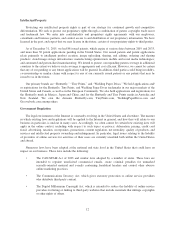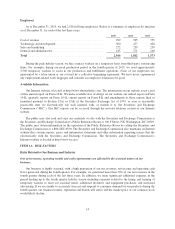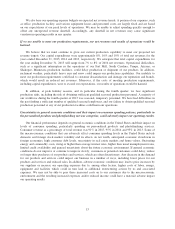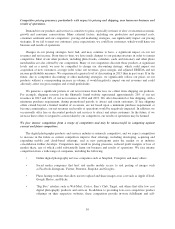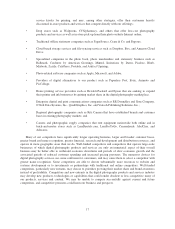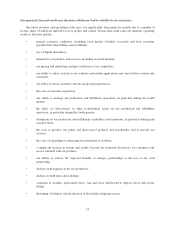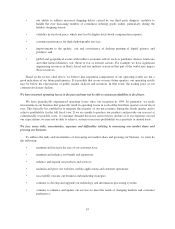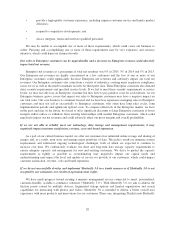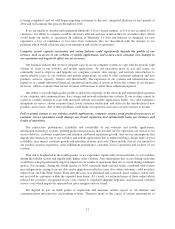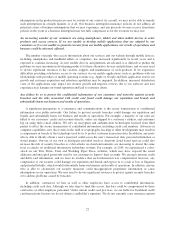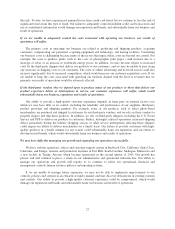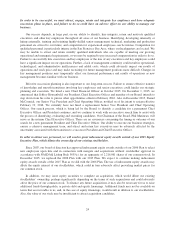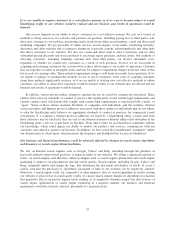Shutterfly 2015 Annual Report Download - page 23
Download and view the complete annual report
Please find page 23 of the 2015 Shutterfly annual report below. You can navigate through the pages in the report by either clicking on the pages listed below, or by using the keyword search tool below to find specific information within the annual report.is being completed, and we will begin migrating customers to the new, integrated platform in first quarter of
2016 and will continue this process throughout 2016.
If we are unable to develop and implement Shutterfly 3.0 in a timely manner, or if it is not accepted by our
customers, our ability to compete could be adversely affected and may result in the loss of market share, which
would harm our results of operations. In addition, if Shutterfly 3.0 does not function as designed, we may
experience a loss of confidence or lost sales from customers who are dissatisfied with the changes to our
platform, which would adversely affect our reputation and results of operations.
Computer system capacity constraints and system failures could significantly degrade the quality of our
services, such as access to our websites or mobile applications, and in-turn cause customer loss, damage to
our reputation and negatively affect our net revenues.
Our business requires that we have adequate capacity in our computer systems to cope with the periodic high
volume of visits to our websites and mobile applications. As our operations grow in size and scope, we
continually need to improve and upgrade our computer systems, data storage, and network infrastructure to
ensure reliable access to our websites and mobile applications, in order to offer customers enhanced and new
products, services, capacity, features and functionality. The expansion of our systems and infrastructure may
require us to commit substantial financial, operational and technical resources before the volume of our business
increases, with no assurance that our net revenues will increase to offset these additional expenses.
Our ability to provide high-quality products and service depends on the efficient and uninterrupted operation
of our computer and communications, data storage and network infrastructure systems. If our systems cannot be
scaled in a timely manner to cope with increased website and mobile applications traffic, we could experience
disruptions in service, slower response times, lower customer satisfaction, and delays in the introduction of new
products and services. Any of these problems could harm our reputation and cause our net revenues to decline.
Full or partial outages to our websites, mobile applications, computer systems, print production processes or
customer service operations could damage our brand reputation and substantially harm our business and
results of operations.
The satisfactory performance, reliability and availability of our websites and mobile applications,
information technology systems, printing production processes and customer service operations are critical to our
service delivery, customer acquisition and retention and brand reputation growth. Any service interruptions that
degrade the satisfactory use of our websites and mobile applications due to undetected bugs, design faults or poor
scalability, may impact customer growth and retention, revenue and costs. These include (but are not limited to)
our product creation experience, order fulfillment performance, customer service operations and security of our
systems.
This risk is heightened in the fourth quarter, as we experience significantly increased traffic to our websites
during the holiday season and significantly higher order volumes. Any interruption that occurs during such time
would have a disproportionately negative impact on our results of operations than if it occurred during a different
quarter. For example, during the fourth quarter of 2014, unusually high seasonal traffic combined with system
misconfigurations arising from our data center migration resulted in some days when customers could not place
orders from our Tiny Prints brand. Even after the issue was identified and corrected, many of those orders were
not received by customers within the expected time frame. As a result, we refunded many of those orders which
reduced net revenues, recognized excess costs related to expedited shipping upgrades, and increased customer
service costs which negatively impacted our gross margins and our brand.
We depend in part on third parties to implement and maintain certain aspects of our Internet and
communications infrastructure and printing systems. Therefore many of the causes of system interruptions or
21



